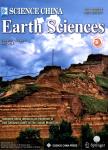Fluvial terraces and their implications for Weihe River valley evolution in the Sanyangchuan Basin
Fluvial terraces and their implications for Weihe River valley evolution in the Sanyangchuan Basin作者机构:Key Laboratory of Western China's Environmental SystemMinistry of EducationCollege of Earth and Environmental SciencesLanzhou UniversityLanzhou 730000China Lanzhou Institute of SeismologyChina Earthquake AdministrationLanzhou 730000China
出 版 物:《Science China Earth Sciences》 (中国科学(地球科学英文版))
年 卷 期:2017年第60卷第3期
页 面:413-427页
核心收录:
学科分类:0708[理学-地球物理学] 09[农学] 0903[农学-农业资源与环境] 0704[理学-天文学]
基 金:supported by the National Natural Science Foundation of China(Grant Nos.41471008,91125008 and 41330745 the Fundamental Research Funds for the Central Universities(Grant No.LZUJBKY-2016-161)
主 题:River terrace Valley evolution Tectonic activity Climate change Sanyangchuan Basin
摘 要:Fluvial terraces are important geomorphic markers for modern valley *** coupled with numeric ages,terraces can provide abundant information about tectonic,climatic,paleohydrological and the paleoenvironmental *** the basis of the paleomagnetic,electron spin resonance(ESR) and optically stimulated luminescence(OSL) dating,in addition to an investigation of local loess-paleosol sequences,we confirmed that 13 fluvial terraces were formed,and then preserved,along the course of the Upper Weihe River in the Sanyangchuan Basin over the past 1.2 *** of the characteristics and genesis of these terraces indicate that they resulted from the response of this particular river system to climate change over an orbital *** changes can further be placed within the context of local and regional tectonic uplift,and represent an alternation between lateral migration and vertical incision,dependent upon the predominance of climatic and tectonic controls during different *** of the terraces are strikingly similar in that they have several meters of paleosols which have developed directly on top of fluvial deposits located on the terrace treads,suggesting that the abandonment of terraces due to river incision occurred during the transitions from glacial to interglacial *** temporal and spatial differences in the distribution patterns of terraces located on either side of the river valley indicate that a tectonic inversion occurred in Sanyangchuan Basin at-0.62 Ma,and that this was characterized by a transition from overall uplift to depression induced by fault *** studies of the Basin s terraces indicate that formation of the modern valley of the Upper Weihe River may have begun in the late Early Pleistocene between1.4-1.2 Ma.



